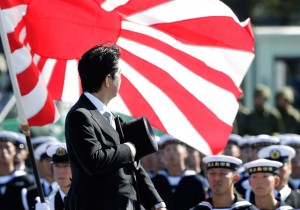The ongoing conflict regarding the territory dispute between China and Japan is provoking heightened military action, particularly with regards to Japan. China’s air-defense identification zone became effective November 23rd. The country stated that it would take “defensive emergency measures” if unreported or unidentified aircraft enter the area. So naturally, the US sent unarmed B52 bombers three days later through the area. Although, this was intended to show the potential peace between the two largest Asian countries, the recent escalation has moved Japan’s national security through independent military capabilities to the forefront of domestic policy.
The zone recently established is over the islands Senkaku, in Japanese, or Diaoyu, in Chinese. The identification area has been produced approximately a year after China bought islands, planes, and ships in the region, previously infuriating Japan. Thus, this conflict is not new, however, the particular military language coming out of China is inducing Prime Minister Shinzo Abe to take more targeted action, especially since the surrounding waters have plentiful oil, natural gas and fish resources.
Regarding America, the US has consistently allied itself with Japan. Despite trying to maintain a generally neutral foreign policy between the two Asian powers, Defense Secretary Chuck Hagel stated that “[the US] view[s] this development as a destabilizing attempt to alter the status quo in the region,” in immediate response to China’s announcement on the 23rd. Continuing on, he reiterated that “this unilateral action increases the risk of misunderstanding and miscalculations” within the region. As a result of a similar perspective, Japan’s Abe has discussed undertaking a 10-year defense plan that can be announced as early as next month, which would focus around Japan’s government adding ballistic missile defense ships and refueling planes to its naval fleet. Abe cited China’s active investment in military spending, which increased 10.7 percent and 11 percent in 2012 and 2011 respectively, as evidence of China’s rising, unhindered military influence in the region. Moreover, the US initiated annual exercises with the Japan Maritime Self-Defense Force on Nov. 25 upon the USS George Washington carrier strike group in order “‘to effectively and mutually respond to the defense of Japan or to a regional crisis,’ according to a statement on the U.S. Navy’s website.” Hence, tensions are rising, and it will be interesting to see how far Japan and America will go as a result of the Chinese militarization and bold acquisition of disputed islands in the region.
Works Cited
U.S. Sent B-52s into China Air Zone, Official Says
China’s Air Defense Zone Aids Abe Push to Bolster Japan Military
I think one important distinction, is that we are not neutral. We have defense treaties and have said that we believe Japan has ownership of the islands, which we gave them after they were defeated in WWII. Thus, any posturing or attempts by US officials to appease the Chinese are appeasement or some kind of compromise. Legally, we are pretty much bound to Japan on this one, base on everything I have read.
The resource-rich waters around the Senkaku seem to be highly sought after. The United States sending multiple B-52 bombers into the no-fly zone is a questionable maneuver. Shinzo Abe’s more targeted actions should be kept minimally invasive if they have to be done. This seems like much ado about nothing. A typical border dispute.